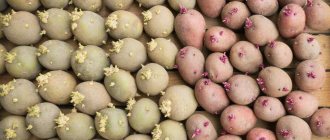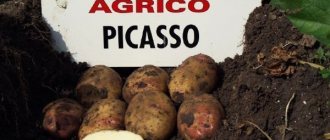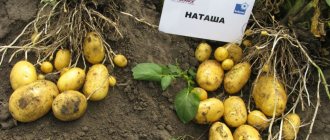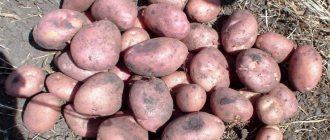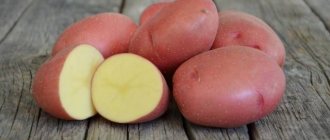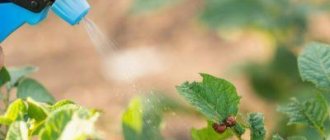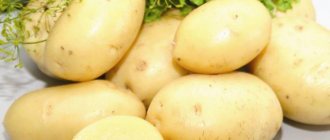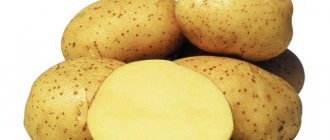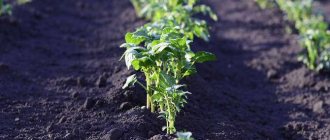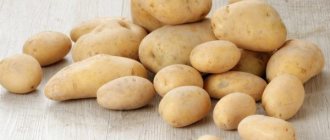General information
Belarus has always been considered a country of second bread. Potato cultivation in these regions occupies an important place in agriculture. The expansion of the potato industry has always been facilitated by local traditions and the deep knowledge of agronomists. An important role in the achievements of breeders was played by good equipment of the technical base and optimal climatic conditions. Potato varieties in Belarus were developed taking into account their growth in different zones of the country. Many of them are grown outside their homeland. The names of many of them are known to Russian gardeners.
The best varieties
If we talk about what the best varieties of potatoes are in Belarus in general terms, then it will be difficult to give a specific answer. It depends on the individual needs of farmers and gardeners. For example, if you need a variety for the production of mashed potatoes (dry), then you need to choose boiled tubers, and denser ones for making chips. For summer residents, early varieties are more suitable, and for private property owners (who have cellars) - late varieties with large tubers.
When choosing a potato variety, the type of soil is taken into account. Therefore, the best type will be the one for which the soil is properly prepared. To have vegetables for all occasions, it is better to plant several types of potatoes at once. This applies to both the ripening period and the quality of the tubers.
And yet, we will try to highlight some of them that have proven themselves to be the most popular in Belarus. The best varieties of early ripening potatoes: Dolphin, Uladar, Lazurit. Late: Rogneda, Zhuravinka, Vesnyanka, Mage and Lasunak. Mid-season: Lileya, Yanka and the most common variety Skarb. Below we will look at some of them in detail.
Description and characteristics of potato varieties in Belarus
Potatoes developed by Belarusian breeders are intended for cultivation in this country. It is grown for agricultural purposes: sold, left for feeding animals, and processed into semi-finished products. Also, many species from Belarus are in demand among gardeners in many countries and regions.
Early, middle and late types according to ripening period have been developed. Many of them tolerate dry periods and spring frosts well. Belarusian potatoes are easy to care for and produce a large harvest.
Important! The later the variety, the higher its resistance to infections.
Early
In Belarus, early potato varieties are successfully cultivated in temperate climate zones. Most of them can be grown in Ukraine and Russia.
- Dolphin. It is distinguished by a high yield of marketable tubers, early yield and good preservation of fruits. The shape of the fruit is oblong, the skin is smooth yellowish, the flesh is light. The taste is excellent, starch is 12-13%, the weight of one fruit is 90-130 g. The duration of ripening from germination to harvest is 1.5 months. Protected against potato canker and cyst nematode, but susceptible to tuber late blight. Is immune to leaf curl and various types of mosaics. The fruits practically do not rot for a long time.
- Uladar. A new variety that has managed to establish itself as an unpretentious and high-yielding crop. Its main characteristics include: drought resistance, early ripening, excellent preservation of root crops, excellent taste of the pulp and undemanding conditions for growing. The shape of the fruit is oval, small eyes are located at the surface level, the skin is smooth, rich yellow. The pulp is creamy, elastic, changes color slightly during heat treatment, and does not become overcooked. Starch content 12-17%. With proper care, the weight of the fetus can reach up to 170 g.
- Lapis lazuli. Table early ripening potatoes with excellent taste. The roots are round, smooth, the eyes are of medium depth. The peel is yellow, the flesh is white. The starch content is average (14%), the weight of one root crop is 115 g. Of the many varieties in Belarus, super-early potatoes, which form tubers in a friendly manner and already after 1.5 months please with the first harvest. It is distinguished by good keeping quality of root crops and resistance to the main diseases affecting nightshades. The tops of the plant are susceptible to late blight.
The article contains photos of potato varieties. There are many types of culture in Belarus, so only a few of them are presented here. In fact, there are 124 varieties included in the state register, and 44 of local selection.
Potatoes: how to choose the best (video)
The best early and mid-early varieties
Currently, there is a gradation of varieties according to ripening time, or so-called ripeness. Super early varieties ripen in less than 80 days. For early potatoes, this period can vary from 80 to 90 days. Potatoes belonging to the mid-early group produce a harvest in 90–100 days.
| Name | State Register of the Russian Federation | Tubers | Pulp | Productivity | Sustainability |
| "Dolphin" | 2002 | Yellow-beige, round | Light yellow | Up to 54 t/ha | Cancer, viruses, late blight, scab |
| "Zorachka" | year 2013 | Yellow-beige, oval | Light yellow | Up to 77.1 t/ha | Nematode, cancer, late blight |
| "Lileya" | 2008 | Yellow, round | Yellow | Up to 67.0 t/ha | Nematode, cancer, late blight |
| "Uladar" | 2011 | Yellow, oval | Light yellow | Up to 71.6 t/ha | Nematode, cancer, viruses, late blight |
| "Breeze" | year 2009 | Yellow, round | Yellow | Up to 60.0 t/ha | Cancer, viruses, scab, late blight |
| "Dina" | 2005 year | Yellow, round | Light yellow | Up to 58.6 t/ha | Nematode, cancer, viruses, late blight |
| "Neptune" | 2006 | Yellow, oval | White | Up to 66.1 t/ha | Cancer, viruses, scab |
| "Odysseus" | 2005 year | Yellow, oval | Light yellow | Up to 66.5 t/ha | Cancer, viruses, late blight, scab |
| "Archidea" | 2002 | Yellow, round | Yellow | Up to 57.6 t/ha | Nematode, cancer, late blight |
| "Manifesto" | year 2014 | Red, oval | Light yellow | Up to 73.7 t/ha | Nematode, cancer, viruses, late blight |
The best mid-season and mid-late varieties
It is mid-season and mid-late potatoes that are popular in the Central Federal District, which is due not only to the excellent taste of the root crops, but also to the long shelf life of the crop. Mid-ripening varieties ripen in 100–110 days, and for mid-late varieties, the ripening period is at least 110–120 days.
| Name | State Register of the Russian Federation | Tubers | Pulp | Productivity, t/ha | Sustainability |
| "Dubrava" | year 2009 | Yellow, round | Cream | Up to 50 | High resistance to cancer, scab, nematode resistance |
| "Sap" | 2002 | Yellow-beige, round | Cream | Up to 55 | Nematode resistance, resistance to cancer, viruses, late blight, scab |
| "Krinitsa" | 2002 | Yellow, round | Yellowish | Up to 49.8 | To cancer, nematode, scab |
| "Treasures" | 2002 | Yellowish-beige | Yellowish beige | Up to 63 | To cancer, nematode, rot |
| "Yanka" | year 2012 | Yellowish-beige | White | Up to 62.6 | Nematode resistance, resistance to cancer, viruses, late blight, scab |
| "Volat" | year 2014 | Yellowish-beige | Yellowish | Up to 62.4 | To cancer, nematode, scab |
| "Lad" | year 2014 | Yellowish-beige | Yellowish | Up to 52 | High |
| "Lasunok" | 1988 | Yellow | Light yellow | Up to 63 | To cancer, late blight |
| "Ragneda" | 2011 | Yellow | Cream | Up to 75.7 | To cancer, nematode, late blight |
| "Crane" | 2005 year | Reds | Cream | Up to 64 | To cancer, nematode, scab |
The best late and very late varieties
Late-ripening potatoes are often affected by autumn frosts and are intended for cultivation exclusively in the southern regions. Late potatoes ripen in 120–130 days, and very late varieties yield a harvest in no less than 130–135 days.
| Name | Maturation | Tubers | Pulp | Productivity, t/ha | Sustainability |
| "Accent" | Late | Yellow | Cream | Up to 57.8 | High |
| "Atlant" | Late | Yellow | Beige | Up to 70.5 | High |
| "Vesnyanka" | Late | Light yellow | Cream | Up to 65.6 | High |
| "Zarnitsa" | Late | Light pink | Beige | Up to 52.7 | High |
| "Zdabytak" | Late | Reds | White | Up to 60.7 | High |
| "Maximum" | Late | Yellowish | Cream | Up to 56.8 | High |
Mid-early
- Lileya. Mid-early classic root vegetables, having the same size and weight (150 g), are large. The shape is round, the surface is smooth, and they are not sensitive to mechanical damage. The peel and pulp are light yellow, the eyes are shallow, and contain about 15-16% starch. Has good immunity to typical potato diseases. Tubers with a long shelf life and excellent transportability.
- Yanka. Because of its marketable appearance, the variety is called Belarusian beauty. High-yielding, unpretentious potatoes adapt well to climatic conditions. When grown for many years, it does not lose its varietal characteristics. Susceptible to some diseases. The tubers are oval, smooth, with a creamy skin and a small number of eyes. The pulp is not overcooked, the taste is rich. Suitable for deep-frying, baking and stuffing potatoes. Starch ranges from 14 to 15.5%.
- Treasures Round-oval tubers, smooth, compactly located in the nest. The eyes are superficial and small. The color of the peel and pulp when cut is rich cream. About 13 tubers weighing from 100 to 130 g are harvested from one bush. Table potatoes (with medium boilability) are intended for preparing salads, frying, and frozen vegetable mixtures. The variety needs moderate moisture. Resistant to wrinkled and striped mosaic, cancer, nematode, wet rot and black leg, has almost 100% fruit shelf life. The most common vegetable in Belarus accounts for approximately 30% of the total area occupied by potatoes.
Soggy
Boiled potato varieties in Belarus are valued for their mild wateriness, moderate mealiness and soft root structure. To a greater extent, these types are used for preparing purees and producing this product in dry form.
- Zdabytak. Technical late variety, with a high starch content (20-25%). Unlike other varieties, it is highly resistant to blackleg, nematode and late blight of tops and tubers. Has average immunity to scab, viruses and rhizoctonia. A moisture-loving crop, suitable for cultivation on all types of soil. The tubers are very tasty, large and very boiled. They are pink in color, oval in shape and have white flesh. In industrial production it is used to produce alcohol and starch. The weight of one fruit is 100-120 g.
- Krinitsa. Potatoes of this type are not characterized by high yields, but are famous for their good consumer qualities. The smooth yellow tubers have a long shelf life and average starch content. They are used for semi-finished products and purees. Their flesh is tender and boils well. The growing season is 100-120 days, the weight of a marketable tuber is 90-130 g. The variety is resistant to almost all diseases, except late blight. Disadvantage: Does not tolerate drought well.
Features of planting and care
In order to get a large harvest from your garden plot every year, you first need to purchase healthy seed material that matches the species.
Before planting, seed potatoes are germinated for 20 days at a temperature of 13 degrees Celsius. The rest of the cultivation technology is no different and includes:
- Weeding;
- Watering;
- Loosening;
- Fertilizers;
- Treatments for the Colorado potato beetle and viral diseases.
- In this case, for a large potato harvest, the soil must also be light and fertile.
Taking a competent approach to growing potatoes, creating the necessary conditions, will be the necessary options for obtaining a good, high-quality harvest.
profermu.com
Late
Late Belarusian potato varieties are intended for cultivation in areas with a warm climate. They can do well in other regions, but there is a danger that they will be subject to frost. The ripening period of such crops is from 120 to 140 days.
- Stonefly. Technical and table variety, resistant to viruses, Alternaria, cancer and nematodes. Moderately resistant to diseases such as scab, blackleg, rhizoctonia and late blight. Large, rounded tubers have yellow skin, small eyes and cream-colored flesh. Root vegetables are suitable for making crispy potatoes, dry mashed potatoes, starch and frozen mixtures. The growing season is 120 days, the weight of the fruit is 90-120 g.
- Zarnitsa. Table potatoes are resistant to all types of diseases, except late blight. The tubers are oval, the skin is red, the flesh is light yellow. Cookability and taste are good, starch content is in the range of 13-17%. It is resistant to drought, has high shelf life of fruits and grows well on all types of soil. Responsive to mineral fertilizers.
- Rogneda. The mid-late variety is suitable for consumption at the stage of conditional maturity; the ripening period of the tubers is 120 days. The shape of the fruit is round or slightly oblong. The smooth, dense peel has a sandy color. The small eyes are located at a medium depth. Root vegetables with a moderate starch content, weigh about 110 g. The taste is sweetish, the pulp is boiled. Main advantages: drought resistance, high yield, shelf life, excellent taste, beautiful presentation. The variety is not picky about soil composition.
Photos of Belarusian potato varieties can be found and viewed in the article.
Mid-late potatoes
Mid-late potato varieties produce a harvest 112-123 days after being transferred to the soil. They are more resistant to diseases and adverse weather conditions. The fruits of these varieties are stored until the beginning of the next season.
Zarnitsa
The tubers are bright pink, round or elongated in shape. Up to 15 fruits are collected from one plant. The average yield is 52.7 tons per hectare of land. In cross section - beige color. After cleaning it does not turn black for a long time. Is immune to the most common potato infections.
Zdabytak
Zdabytak forms medium oval fruits. The peel color is bright burgundy. In cross section - white, with a pink tint. One hectare of land produces 60 tons of potatoes. It is considered high-yielding. The tubers contain more than 20% starch; when cooked, the fruits become soft. This variety is demanding when it comes to watering.
Maximum
The maximum forms root vegetables of medium size, the skin is brown, in cross-section it is light, yellowish. Contains 17-20% starch, which is why it boils soft after heat treatment. The harvest is stored for a long time. Bushes are immune to pests and diseases. They do not require much care, bear fruit well in poor soils, and are resistant to drought.
Popular yellow varieties
The Belarusian selection is rich in a large assortment of potatoes with yellow flesh. Many of these varieties are valued for their unpretentiousness and undemanding growing environment. The yellow varieties of mid-early potatoes in Belarus include: Breeze, Dina, Arhidea.
- Breeze. The result of the successful work of Belarusian breeders. An undemanding crop with a ripening period of 2.5 months from the time of planting. This makes it possible to grow it in all regions of Belarus. Large oval tubers with yellow skin and many eyes. The digestibility of the fruit is average, the taste is sweetish. Suitable for freezing and frying. The downside is that the plant is susceptible to golden nematode and is moderately resistant to scab and late blight. The variety is quite resistant to viral diseases.
- Dina. Mid-early variety for table use. The tubers are almost round with small eyes. The peel is yellow, rough, the flesh is lighter. Starch content from 10 to 19%. It is protected from nematodes and cancer, and also has good commercial qualities. Compared to other varieties, it differs in early tuber formation and the intensity of their growth.
- Orchid. Table, mid-early variety, producing stable yields. Drought-resistant, transportable, quickly adapts to the soil. Ripening period is 2.5-3 months. Resistant to nematode, wet rot and blackleg, but susceptible to top blight and scab. It is grown under standard agricultural technology. The peel and pulp are yellow, do not darken when cut, boil well, and are ideal for making purees. The mass of the tubers is up to 100 g, the starch content is 17-21%.
Mid-season
Let's dwell only on some high-yielding and nematode-resistant ones:
- Variety Zhivitsa - with round-oval tubers (10-14 per bush) with yellow skin and creamy pulp (starch 12.5-18%). It is characterized by a long physiological dormant period of tubers. It produces higher yields on light and medium soils and responds well to intensive growing conditions. With uneven growth, tubers are prone to cracking. Resistant to viral diseases, medium - late blight.
- The entire Pskov region has been “conquered” by the high-yielding variety Skarb - it is extremely popular there. It has large, oval, attractive-looking tubers (10-14 per bush) with yellow skin and pulp (starch-12-17%).
This variety is unique in its yield, marketability and keeping quality; suitable for all types of soils, while effectively using their natural fertility; characterized by a high return on fertilizers applied.To obtain faster and more uniform germination, germination or heating before planting is recommended. The Skarb variety is moderately resistant to late blight.
- Color - with large oval-elongated tubers (8-10 per bush) with pink skin and light yellow pulp (starch 12.8-18.7%). Moderately resistant to late blight on leaves, weakly resistant to tubers. When planting, it requires a soil temperature of at least 8...10°C.
- Krinitsa - with round tubers (12-16 per bush) with yellow skin and pulp (starch 14.4-19.7%). Moderately resistant to late blight. It is characterized by excellent taste (good cooking properties, tender pulp). Light and medium soil composition are considered optimal for cultivation. Requires cold storage (1...3°C).
- Rosinka - with large round-oval aligned tubers (9-12 per bush) with yellow skin and light yellow pulp (starch 14-18%). Moderately resistant to late blight. Reliable in extreme soil and climatic growing conditions; keeping quality is very high.
floraprice.ru
Other varieties
Some Dutch potato varieties are also cultivated in Belarus. These include Rocco and Red Scarlet.
- Red Scarlet. An early table variety, characterized by a high starch content (18.6%). Resistant to potato blight and nematode, partially to late blight. Main characteristics: early, high shelf life and marketability of fruits, produces a large number of tubers, suitable for packaging. The tubers are elongated, with red skin and yellow flesh.
- Rocco. Mid-season table potatoes with high immunity to many diseases (even viral ones). Valued for its good taste and productivity. The fruits are oblong and smooth. The flesh is yellow, the skin is pink with small eyes.
Some tips
All potato varieties in Belarus are grown according to standard agrotechnical rules. Below are some recommendations that have helped experienced gardeners get better results from their harvest.
When planting tubers, the sprouts are placed upward. To ensure uniformity of seedlings, they need to be placed at the same depth.
It is important to ensure that a layer of loose soil remains under the root crops.
To ensure light conditions, plants are placed in even rows with the same distance.
You need to pour a little ash into each hole. This will not only enrich the potatoes with essential microelements, but also protect against certain diseases.
Recipe from a scientist: potatoes in a slow cooker
We return from the market with purchases. Let's go cook Zhuravinka, Lileya and Breeze. Lyudmila Kozlova reminded: the healthiest potatoes are baked in the oven in their skins or steamed.
And she offered her recipe, which allows you to preserve the nutritional value as much as possible.
— Take the potatoes, wash them, peel them and cut them into four parts. If the potatoes are young, you don’t need to peel the peel; for mature ones, you need to cut them as thin as possible. Mix all the parts with salt, add a little vegetable or butter and put in a slow cooker. Cooking mode: “baking”, time: 30 minutes.
Fortunately or unfortunately, after tasting the three varieties, I was still unable to determine which of the three potato varieties I liked better. Maybe "Crane"? Probably because it’s extremely nice to know that you’re getting so many antioxidants!
Potato varieties in Belarus differ in their marketability and shelf life percentage. Suitable for cultivation in areas of Russia, Ukraine, Moldova. Selection was carried out separately for a specific climatic zone of the country, of which there are three. This gave results - the yield turned out to be consistently high without taking into account the composition of the soil, temperature fluctuations and humidity levels.
Vernalization of tubers
Root crops that have undergone vernalization germinate more quickly and produce better yields. During this procedure, it is easier to select planting material. Shoots appear 10 days after planting, and tuber ripening is accelerated by 15 days.
- You should break off the sprouts that formed during the winter storage of potatoes.
- Then place the tubers in boxes in a layer of 3 tubers. Ideally, root vegetables are laid out in one layer, if possible.
- Choose a bright place, preferably near a window. The vernalization period is 40 days. The room must be periodically ventilated and the temperature regime must be maintained (+15°C).
- Root crops must be turned over once a week and the germination process observed. Healthy sprouts should be thick, strong and colored (depending on the potato variety). Their height should not be allowed to reach more than 1 cm.
Rules for planting potatoes in Belarus
The potato planting period usually begins in the second half of April. Since even in early April night frosts are possible. In this case, the ground may freeze to 5-10 cm; usually, planted potatoes can be located at this depth. At the beginning of April, only early potato varieties can be planted. But in this case, after planting, it is necessary to cover the areas with potatoes with film or spunbond so that frosts cannot damage the seedlings. The end of March may bring snow, so planting potatoes during this period is not yet recommended.
Important! Ideal conditions for planting potatoes will be when the soil temperature warms up to +5C
When planting potatoes, the planting method is important. As a rule, there are three types of traditional planting: smooth, ridge and trench. Each planting option is designed for specific conditions. The main requirement when planting using any of the methods is that the planting location should be from north to south. This is necessary to ensure that the plants receive enough light and sunlight during ripening.
When planting, it is also worth maintaining a distance between the rows and the planting material, since the plant will grow and it is necessary to leave room for it. This will also help when harvesting, so as not to damage the grown crop with a shovel.
It is important to know! The recommended distance between rows of tubers of early varieties is 60 cm, late varieties - 70 cm. The distance between seeds in a row of early varieties is 25 - 30 cm, late - 30 - 35 cm. Planting depth for light soils is 10-12 cm, for heavy soils 8-10 cm, for clay soils 4-5 cm.
It is necessary to prepare the soil for planting potatoes in the autumn. When digging up a site, you should add the following mixture of fertilizers per 1 m2: 1 bucket of compost, 30g of superphosphate, 15g of potassium salt. In the spring, immediately before planting potatoes, the soil must be fed with nitrogen fertilizers.
